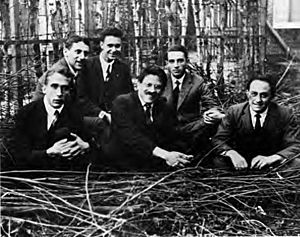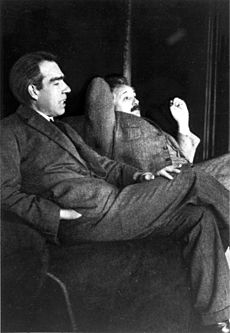Paul Ehrenfest facts for kids
Quick facts for kids
Paul Ehrenfest
|
|
|---|---|

Ehrenfest in c. 1910
|
|
| Born | 18 January 1880 |
| Died | 25 September 1933 (aged 53) Amsterdam, Netherlands
|
| Citizenship | Austrian (pre-1922) Netherlands (post-1922) |
| Alma mater | Vienna University of Technology University of Vienna University of Göttingen |
| Known for | Ehrenfest theorem Ehrenfest paradox Ehrenfest equations Ehrenfest model Coining the term 'spinor' Coining the term 'ultraviolet catastrophe' Ehrenfest classification Ehrenfest–Tolman effect Nonradiation condition Privileged character of 3+1 spacetime Timoshenko–Ehrenfest beam theory Ehrenfest time |
| Spouse(s) | Tatyana Alexeyevna Afanasyeva |
| Children | Tatyana Ehrenfest Galinka Ehrenfest Paul Jr. Ehrenfest Vassily Ehrenfest |
| Scientific career | |
| Fields | Physicist |
| Institutions | University of Leiden |
| Doctoral advisor | Ludwig Boltzmann |
| Doctoral students | Johannes Martinus Burgers Hendrik Casimir Dirk Coster Samuel Goudsmit Hendrik Kramers Arend Joan Rutgers Jan Tinbergen George Uhlenbeck |
| Other notable students | Gregory Breit Paul Sophus Epstein Viktor Trkal Gerhard Heinrich Dieke Gunnar Nordström |
| Influenced | Ralph Kronig Mark Kac |
Paul Ehrenfest (born January 18, 1880 – died September 25, 1933) was an important Austrian theoretical physicist. He made big discoveries in how tiny particles behave. He also studied how matter changes from one state to another.
Ehrenfest became good friends with Albert Einstein in 1912. He later became a professor at Leiden University in the Netherlands. He often invited Einstein to visit him there.
Contents
Paul Ehrenfest's Early Life
Paul Ehrenfest was born in Vienna, Austria. His parents were Jewish and owned a grocery store. Even though his family was not very religious, Paul learned about Jewish history and the Hebrew language. He always remembered his Jewish background.
Paul was a very good student in elementary school. He struggled a bit in high school at first. But after changing schools, his grades got much better. He finished high school in 1899.
University Studies and Early Career
Ehrenfest first studied chemistry at the Vienna Institute of Technology. He also took classes at the University of Vienna. There, he learned from Ludwig Boltzmann, a famous physicist. Boltzmann's lectures on how gases behave really inspired Paul. These classes made him want to study theoretical physics. This field became his main focus for many years.
It was common back then to study at different universities. So, in 1901, Ehrenfest moved to the University of Göttingen in Germany. This university was a major center for math and physics. There, he met Tatyana Afanasyeva, who would become his wife. She was a mathematician from Kyiv, Ukraine.
In 1903, he met the Dutch physicist Hendrik Lorentz in Leiden, Netherlands. Paul finished his Ph.D. degree in Vienna in 1904. His paper was about how solid objects move in liquids.
On December 21, 1904, Paul married Tatyana. They worked together on many scientific projects. They had four children: two daughters and two sons. Their daughter Tatyana also became a mathematician. Their daughter Galinka wrote and illustrated children's books. Their son Paul Jr. became a physicist too.
Moving to St. Petersburg
In 1906, the Ehrenfests moved back to Göttingen. Sadly, Boltzmann, Paul's mentor, passed away that year. Paul wrote a long article praising Boltzmann's work. A professor named Felix Klein then asked Paul to write a review about statistical mechanics. Paul and Tatyana worked on this for several years. The article was published in 1911. It was known for its clear thinking and smart examples.
In 1907, the family moved to St. Petersburg, Russia. Paul made good friends there, like physicist Abram Ioffe. However, he felt alone scientifically. He also couldn't get a permanent teaching job because he didn't belong to any religious group.
Becoming a Professor in Leiden
In 1912, Ehrenfest traveled to different universities in Germany. He hoped to find a teaching position. He met famous physicists like Max Planck and Arnold Sommerfeld. In Prague, he met Albert Einstein for the first time. They became very close friends. Einstein even suggested Ehrenfest take his place in Prague. But this didn't happen because Ehrenfest was an atheist.
Then, something unexpected happened. Professor H. A. Lorentz retired from Leiden University. He suggested Paul Ehrenfest as his replacement. So, in October 1912, Ehrenfest became a professor in Leiden. He stayed there for the rest of his career.
Paul Ehrenfest's Academic Career
Ehrenfest started a discussion group for physics students in Leiden. He called it De Leidsche Flesch, which means "The Leyden jar". He invited many important physicists from around the world to give talks. Ehrenfest was a great debater. He was quick to find weak points and explain the main ideas clearly.

In his classes, he used simple examples to explain difficult ideas. His classes were small, and he spent a lot of time with his students. He talked with them almost every day. If he felt a student needed more training, he would send them to other universities in Europe. He also encouraged his students to work abroad.
Notable Students and Colleagues
Many of Ehrenfest's students became famous scientists. These included Johannes Martinus Burgers, Hendrik Kramers, Dirk Coster, George Uhlenbeck, and Samuel Goudsmit. Uhlenbeck and Goudsmit are known for discovering the idea of electron spin. Jan Tinbergen, another student, later won the first Nobel Prize in Economics.
Other young scientists who visited his lab included Enrico Fermi, Werner Heisenberg, and Paul Dirac. Ehrenfest was elected a member of the Royal Netherlands Academy of Arts and Sciences in 1919.
Paul Ehrenfest's Research
Most of Ehrenfest's scientific work focused on basic principles. He wanted to make things clearer and solve confusing problems. He was known for his clear writing and for asking interesting questions. He didn't like the very abstract ideas of the new quantum theory at first.
Key Contributions to Physics
From 1912 to 1933, Ehrenfest's most important work was on "adiabatic invariants." This idea comes from classical mechanics. It helped improve Niels Bohr's model of the atom. It also connected atomic physics with statistical mechanics.
He made big contributions to quantum physics. This included the theory of phase transitions, which is how matter changes state. He also developed the Ehrenfest theorem. This theorem says that the average behavior of a quantum system follows the rules of classical physics.
His name is also linked to the Ehrenfest paradox, a puzzle in relativity. The Ehrenfest model and Ehrenfest time are also named after him.
Interest in Economics
Ehrenfest was also interested in using math for economic theories. He thought there might be a link between how heat behaves (thermodynamics) and how economies work. He didn't publish much on this himself. But he encouraged his student Jan Tinbergen to study it. Tinbergen's Ph.D. paper covered both physics and economics. He later became a famous economist and won the first Nobel Memorial Prize in Economic Sciences in 1969.
Einstein and Bohr in Leiden

Ehrenfest was very close friends with both Albert Einstein and Niels Bohr.
In 1920, Einstein accepted a special professor position at Leiden University. This meant Einstein could visit Leiden for a few weeks each year. During these visits, Einstein would stay at Ehrenfest's home. In 1923, Einstein stayed for six weeks. This was because he faced threats in Berlin.
In 1925, Ehrenfest invited both Bohr and Einstein to Leiden. He hoped they could settle their scientific disagreements about the new quantum theory. These discussions continued at a big conference in 1927. Ehrenfest, though sad to do so, sided with Bohr in this important debate.
Paul Ehrenfest's Legacy
The monthly evening physics discussion at Leiden University still happens today. Paul Ehrenfest started it in his home in 1912. It is now called Colloquium Ehrenfestii.
The Austrian Institute for Quantum Optics and Quantum Information gives an annual award. It is called the Paul Ehrenfest Best Paper Award for Quantum Foundations.
The Dutch Physics Council also gives an annual award. It is called the Ehrenfest-Afanassjewa thesis award.
Images for kids
-
Ehrenfest's students, Leiden 1924. Left to right: Gerhard Heinrich Dieke, Samuel Abraham Goudsmit, Jan Tinbergen, Paul Ehrenfest, Ralph Kronig, and Enrico Fermi
-
Niels Bohr and Albert Einstein debating quantum theory at Ehrenfest's home in Leiden (December 1925)
See also
 In Spanish: Paul Ehrenfest para niños
In Spanish: Paul Ehrenfest para niños




